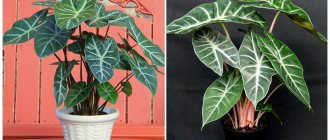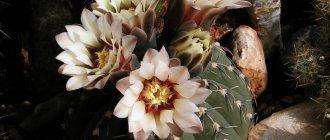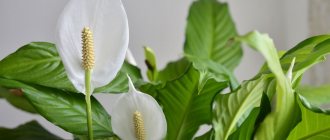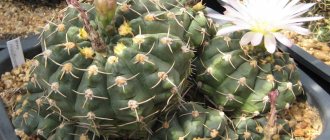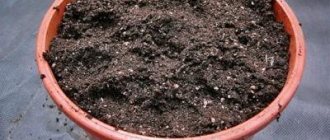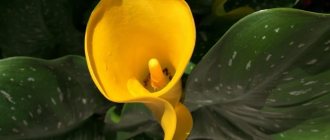Gymnocalycium stellate
The stem is dark green, regularly rounded, with spines peeking out from the fluffy areoles. The needles grow down and in different directions, which is why the cactus appears to be covered with stars.
In addition to the above-described species, Gymnocalycium Bruch, Small-flowered, Nude, Schroeder, Besa, Rubra and others are grown indoors.
Popular types
"Gymnocalycium Mihanovich"
This is a succulent with a wide, sometimes slightly elongated grayish-green or red-brown stem about 5-6 cm and a spherical elongated ribbed stem.
The narrow triangular ribs are decorated with a wavy edge with a slight thickening and long, about 1 cm, curved gray spines.
During the flowering period, a funnel-shaped rather large flower appears at the top of the plant: its size with a trunk diameter of 6 cm is about 7-8 cm.
Pure white and pinkish flowers are the most common. Their shape can also be different: from tubular to fully opening inflorescence.
In the photo “Gymnocalycium Mihanovich”:
"Friedrich"
Cactus "Friedrich" is a variety of the plant "Gymnocalycium Michanovich". In 1940, Japanese breeders noticed that, as a result of a mutation, some of the flowers of Gymnocalycium Friedrich had a bright color unusual for this species.
By repeatedly crossing mutant plants, they became completely chlorophyll-free: deep red specimens are more common, but there are also yellow, dark and light burgundy and even orange varieties.
The variety of Japanese "Friedrich" is equipped with a red shoot-shaped stem with a diameter of up to 10 cm, sharp triangular ribs with a dark edging and curved grayish-brown spines. It blooms lilac-pink. Due to the lack of chlorophyll, it grows only on the rootstock: it is grafted onto slow-growing types of succulents.
In the photo “Gymnocalycium Friedrich”:
"Humpbacked Gymnocalycium"
It received such a strange name (sometimes this type of spherical succulent with creamy, almost white flowers is called tuberous) because of its unusual appearance. With age, its central spine becomes overgrown with shorter radial ones, resembling tubercles.
It grows up to 50 cm and can have a diameter of up to 15-20 cm . Its ribs (there are from 12 to 19 on the plant) are separated by transverse grooves and look like separate segments.
The yellow spines, which often have a reddish base, are located on the fleshy papillae and are slightly curved. During the flowering period, several large flowers with a diameter of 6.5 cm appear on a wide tube. In the photo “Gymnocalycium Humpbacked”:
"Small-colored"
It is a small plant with a slightly flattened stem measuring 7 cm , low ribs and flowers on high tubes.
Its petals are white: only their bases are slightly reddish.
"Tiny"
This is the smallest type of “Gymnocalycium”: its size does not exceed 3 cm. The spherical stem is colored brown-green with a hint of ashen and has small ribs. The central spines are completely absent, the radial spines are slightly curved and pressed against the stem.
By spring, fairly large white flowers bloom on it.
In the photo “Gymnocalycium Tiny”:
"Andre"
“Andre” has a completely atypical color for its species: its flowers form bushes with many heads of bright yellow, almost canary color. Its stem is dark green and equipped with spines pressed against it. The plant requires shading and very moderate watering.
It does best when planted in groups in flat containers.
In the photo “Gymnocalycium Andre”:
"Baldianum"
"Baldianum" can be recognized by its dark green stem with a slightly bluish tint, flat ribs with transverse grooves and almost white areoles in which curved brown spines are attached.
Flowers appear quite early: at the beginning of summer, unusual purple flowers, rarely found in nature, appear on Baldianum.
In the photo “Gymnocalycium Baldianum”:
"Bruja"
This succulent, named after an Argentine entomologist, produces a lot of shoots. “Bruja” is not too large: its height is about 6 cm and its diameter is about 5 cm. The light pink flowers have a darker stripe in the center.
“Areoles” with curved white spines are very often located. Depending on the number of radial spines, several forms of this species are distinguished.
In the photo “Gymnocalycium Bruch”:
"Naked"
It has a glossy green stem, flat ribs with small transverse grooves (there can be from 5 to 8). The areoles are equipped with a small number of spider-like spines: light brown, and in older plants, gray.
The flowers on a high tube are white or pinkish, have narrowed and slightly curved petals. Its stem lengthens over the years and forms side shoots. In the photo “Gymnocalycium Naked”:
"Multifloral"
The stem has a non-standard shape for “Gymnocalyciums”: flattened, 6-9 cm tall , it forms a bush. Its diameter is slightly larger: 8-11 cm . Number of ribs: 10-15.
Large areoles are equipped with 7-10 yellowish, slightly protruding spines. Flowers measuring 4 cm are mounted on short tubes.
In the photo “Gymnocalycium Multiflorum”:
"Salona"
This large (up to 30 cm in diameter) succulent with bell-shaped flowers on short tubes is often grown in greenhouses.
Even its spines are a kind of decoration: up to 2.5 cm , curved, they form elegant rosettes.
In the photo “Gymnocalycium Salona”:
"Shredder"
This type of “Gymnocalycium” is equipped with a flat stem: its height does not reach 5 cm with a diameter of 15 cm.
It is equipped with 9-18 low ribs and 5-7 thin straight spines growing from each areole. White or slightly cream flowers have a thin tube.
In the photo "Schroeder's Gymnocalycium":
"Besa"
"Gymnocalycium" subspecies "Besa", like all "Shredders", has a spherical single stem. However, its spines are thinner, and the ribs with sharp humps are less tuberous.
In the photo “Gymnocalycium Bes”:
"Rubra"
Its main difference is a bright red stem with low ribs, so even outside the flowering period it looks unusually elegant.
“Rubra” breeds very easily, as it grows with a large number of children. The largest specimens measure about 6 cm.
Blooms less frequently than other species.
In the photo “Gymnocalycium Rubra”:
"Anizitsi"
The main feature of "Anizitsi" is the bright green, rich color of the stem up to 8 cm in size and thin spines of different lengths.
The large white corollas of the flowers are funnel-shaped.
In the photo “Gymnocalycium Anizitsi”:
"Mix D-5"
Cactus "Gymnocalycium Mix" is a mixture of miniature species that perfectly coexist in one container. The designation D5 corresponds to the diameter of the container - 5 cm.
How to care for the Gymnocalycium Mix cactus? This question worries many gardeners.
Caring for Gymnocalycium Mix d 5.5 does not present any particular difficulties. The plant does not need spraying. It needs to be watered in the spring. Cactus propagates by cuttings.
For most species, cuttings take root easily in spring or summer.
The cuttings are dried for several days (large cuttings will require 1-2 weeks) before planting in a peat-based substrate.
Reproduction by seeds is possible at 17-25°C.
In the photo “Gymnocalycium Mix”:
Soil moisture
Watering Gymnocalycium correctly is not difficult - the principles apply to almost all plants living at home. It is irrigated as the soil in the pot dries. Watering should preferably be done with settled water heated at room temperature.
In summer, the plant is watered moderately but regularly, and from autumn to spring it is watered occasionally and little by little. It is important to take care of drainage, pour out excess liquid from the pan and allow the earthen clod to dry completely between waterings.
Reproduction and replanting at home
Gymnocalycium can be propagated by seeds and vegetatively.
When propagated by lateral layering, the grown shoot breaks off or is unscrewed from the mother trunk. The cut site is dried, then the shoot is placed vertically in damp soil. A small cactus takes root after 7-14 days.
Sometimes cuttings have their own roots intertwined with the root system of the mother. In this case, the roots of the shoot are carefully dug out and it is planted in a separate pot.
How to replant a cactus
The process of transplanting the hymnocalycium is shown in the photo:
- Wait for spring.
- Prepare a container of similar size.
- Separate the side shoot from the main stem.
- Dry the cut area for two days in a dark place.
- Moisten the soil and plant a new plant.
You can also choose seed fondant, for which all you need to do is: buy seeds, pour them onto moist soil, cover them with film and wait for them to germinate.
Gymnocalycium is an unusual miniature cactus, decorated by nature with a spectacular bright flower. It is easy and simple to care for, but the flowering period lasts several months. What else does a gardener need?
Propagation by seeds
Propagation by seeds is more troublesome, but gives better results. With this method, it is more likely to get strong and healthy offspring.
The container for planting is small and shallow. It is important not to let the soil dry out. To maintain moisture, the pot must be covered with a transparent lid or film and placed in a sunny place. Every day you need to ventilate the ground for 10-15 minutes and wipe off any condensation that has formed from the film.
Shoots appear quite quickly - after 2-3 weeks. You can transplant grown plants into separate pots when they acquire their own thorns.
If the requirements for light and heat are met, seeds can be planted at any time of the year.
Do I need to fertilize?
If desired, the soil can be fed, not forgetting that:
- We fertilize only in the spring-summer season.
- No more than once every two weeks.
- We use special mixtures and formulations selected for cactus species.
However, the cactus has no special requirements for feeding: this plant, like all tropical varieties, is capable of existing in completely spartan conditions.
Transfer
Replanting should be done as the shoot grows, choosing the next pot a little larger than the previous one. In addition, replanting will be necessary if the roots rot. A young plant develops faster, so it can be moved to a new pot every year, then this will be required every 2-3 years. It is advisable to change the pot in the spring.
Before planting, the roots are carefully cleaned of remaining soil, washed with hot water and dried for 2 days. Then the plant is placed in fresh substrate. The pot is selected taking into account its ability to drain excess liquid. The cactus is placed in unmoistened soil and watered after a couple of weeks.
In case of diseases of the root system, the damaged pieces are first removed.
If the plant has flowers, then its habitat is changed after they dry.
Botanical description
Gymnocalycium cactus is a plant with a flattened spherical stem of brownish-green, brown, gray or grayish-green color with a diameter of 4 to 15 cm and a height almost half the diameter. The stem has from 10 to 32 vertical ribs, covered with areoles with tufts of spines 13 to 38 mm long: in the center of each areole there are from 3 to 5 long straight needles surrounded by shorter radial spines.
Bell-shaped flowers of Gymnocalycium with a diameter of 2 to 7 cm with several rows of lanceolate petals and closed cups devoid of spines and pubescence are formed at the top of the stem from May to November. The color of the flowers can be red, crimson, yellow or cream. The red, purple or green fruit of Gymnocalycium, up to 4 cm long, is ovoid and covered with scales.
In the photo: Blooming cactus Gymnocalycium
Breeders developed chlorophyll-free cultivars of Gymnocalycium with red and yellow stems. They are grown by grafting onto a green cactus. The first hybrid of Gymnocalycium with a red stem was grown by the Japanese Eiji Watanabe.
- How to care for ficus
Diseases and treatment of Gymnocalycium
To protect your plant from diseases and pests, you need to avoid drafts, high humidity, and excessive watering.
The main disease of Gymnocalycium is root rot. This problem occurs when the watering regime or temperature conditions are not observed, or the soil is too fertile.
To fix the problem, you need to rinse the roots with warm water and cut off the affected fragments. Healthy parts should be sprinkled with ash or crushed coal, allowed to dry for several days and returned to the soil.
The main pests of this cactus are red flat mites and mealybugs.
Geography of habitat
The homeland of this cactus is considered to be South America, Bolivia, Uruguay, Southern Brazil, North-Eastern Argentina, the variety is widespread in Paraguay. Natural habitat - mountain tops, river valleys. They most often grow in groups, forming decorative compositions.
A distinctive feature of the variety is the “bare tube”; the flower tubes do not have bristles or hairs ; unlike other cacti, they are covered with smooth small scales.
These cactus varieties do not have chlorophyll. Therefore, for full growth and nutrition, they are grafted onto other slowly growing cacti (we talked in detail about other varieties of cacti here, and from this article you will learn how quickly a desert plant develops at home and why it does not increase in size).
Red flat tick
The red flat mite manifests itself by the presence of rust-colored spots on the body of the trunk; the insect itself is very difficult to see. This mite is not found often because the skin of the cactus is too thick for it. Young shoots with thin, immature epithelium are susceptible to tick attack.
The fight against it is very simple - you need to wash the stems with very warm water or treat it with ethyl alcohol. Pesticides should only be used as a last resort.
Mealybug
This pest settles on stems and roots. It can be seen with the naked eye - it has a pinkish body covered with an airy layer similar to cotton wool, leaving behind a white coating. A sign of infestation by this worm-like pest will be stunted growth and lack of flowering.
To get rid of these parasites, it is enough to wash the entire plant with roots with hot water or use universal preparations to combat the pest.
Gymnocalycium, with proper care, can become an interior decoration. After all, it has an incredible range of shades, decorative appearance, beautiful flowering and unusual shapes.
This cactus does not require special skills in growing indoor plants; you just need to follow the rules of lighting, watering and temperature conditions - even a beginner can handle it. As a result, Gymnocalycium will delight its owner with beautiful flowers and unusual appearance.
Care
On the Internet you can find a large number of photos with this cactus posted by housewives. The plant is unpretentious , and therefore you do not need to be a professional agronomist to successfully grow it.
- Selection of location and lighting . A good location for planting a cactus is the western or eastern sides . This is due to the optimal amount of sunlight in these places. On the south side, plants must be shaded to avoid burns. Lack of light affects late flowering: autumn buds may not bloom.
- Temperature . In winter, the temperature in the room should correspond to 10-15 degrees, and in summer 15-30 . When growing a plant, you need to take into account that the exotic seedling does not tolerate drafts and sudden temperature changes.
- Watering and humidity . From late spring to early autumn, the soil is watered as it dries . In the cold season, the variety requires much less moisture. The frequency of watering for the plant is sharply reduced. Gymnocalycium prefers dry air, so it does not need spraying, even in summer.
- Soil and fertilizing. For varieties of the cactus family, slightly acidic soil is suitable. They should be fed in the spring with a special fertilizer for cacti, which is sold in flower shops.
- Transplant . For young gymnocalycium, the procedure is performed annually , then as needed: approximately once every three years, when the roots become crowded. For planting, select a pot slightly larger in size than before. The old soil lump is cleared in half, the remaining space is filled with fresh, prepared soil, consisting of earth, sand, peat and pieces of charcoal.
- Reproduction . Most of the developed varieties are propagated by seeds. Vegetative propagation involves planting young stems, separating them from the mother root. Some species, such as Bruch's Gymnocalycium, quickly form side shoots and are therefore easier to propagate this way.
- Vaccination rules. Most species specimens do not require vaccination . It is needed only for colored, chlorophyll-free plant varieties. The basis is an ordinary green cactus, the surface of which is cut with a blade. A planted plant with the same cut must be pressed tightly against it and fixed for about a week using a suspended weight.
This video shows how vaccination occurs:
Important! When the tissues grow together, this will mean that the grafting was successful.

